 Leading Blog | Posts by Month |
 Leading Blog | Posts by Month |
05.31.19

LeadershipNow 140: May 2019 Compilation
See more on 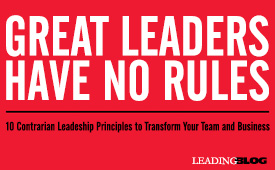 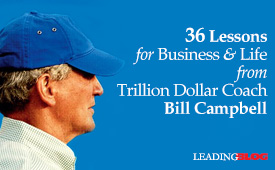
Posted by Michael McKinney at 07:05 AM
05.29.19

Business Lessons from the Top 0.01%
MORE THAN 400 climbers have reached the summit of Mount Everest. There are currently 2450 active Navy Seals. 536 astronauts have journeyed into outer space. But since 1946, only 257 pilots have flown as Blue Angels. In other words, 0.01% of all U.S. military pilots in history have achieved the unparalleled performance symbolized by the Blue Angels gold helmet. And consider this. Throughout the Navy, all personnel are reassigned every three years. That means for the Blue Angels, each year, roughly a third of their colleagues and half of their leadership are brand new. That kind of disruption would put a huge strain on any team if the culture were not designed to handle it. Former lead solo Blue Angel pilot John Foley writes in Fearless Success: “In a high-performance organization, individual talents will come and go, but the culture and the process of the organization need to be so strong that change doesn’t negatively impact forward motion.” Could your team or organization continue to function a high level with that kind of change? What the Blue Angles do is inherently unforgiving. They must get it right each and every time they are called on to perform. Just getting by is not an option. Foley shares how the Blue Angels make that happen—the processes, the culture, the values. But fundamental to all of it—always running in the background—is a mental approach he encapsulates as the Glad To Be Here mindset. That phrase drove them to be the best they could be. Glad to Be Here Mindset Glad to be Here is about respect and gratitude. It represents a shared purpose that is larger than the self. It requires a large degree of self-awareness. It is the “differentiator, the spark, that ignites all of the key elements that teams are looking for, such as chemistry, trust, and camaraderie. When people actively engage with this emotion and allow it to define their being, it promotes a state of mind that allows for open and honest human interactions with more efficient outcomes.” I found it especially instructive that they used it in their debriefings. I’m jumping ahead a bit here, but this is critical. You can really see the value of this mental approach in action. As each team member contributes to the debrief, they end their comments with “Glad to be here.” And here’s why: “This statement reaffirms your commitment to the team, and over time, it can remind you of your purpose larger than self. It’s an acknowledgment for your thankfulness to have the opportunities and challenges that life presents. While emotions vary day to day, the intent is to stay aligned to a positive mindset.” It signals to the other team members that my comments reflect my commitment to the purpose of the team. “We are aligned.” Glad To Be Here is most important in times of trial. Reminding yourself of the sources of your gratitude is an awesome way to drive out fear and immobility. It connects you back to your higher purpose. It refocuses the mind on the positivity, allowing you to spot new opportunities for innovation and execution. It’s the differentiator that can turn a bad situation into a great success. Now on to the process. The Diamond Performance Framework This framework (DPF) takes the basic concepts of vision, plan, execution, and feedback to a new level. The DPF provides a process to achieve high performance. It is a cyclical process designed with continuous improvement in mind. What unifies the DPF is the CenterPoint. The CenterPoint is your “north star,” and every team needs one. It is your reference point for all decisions. “It provides you with a sense of ‘true north’ that allows you to react quickly in changing situations. It keeps individuals and teams focused on specific goals and outcomes.” Ask yourself, “What is the CenterPoint of my life? What is the one thing that all of my actions flow through, that informs key decisions I make?”
1. Belief: High performance begins with a belief, and we perform at our belief level. If you raise your beliefs, then you can raise your performance. If you never raise your beliefs above your current reality, you can never achieve the performance of the top 1% of performers in their field. So, we have to be clear about our beliefs and then ask how do I raise those belief levels. On a path of continuous improvement, you are constantly resetting your goals to the next level. So, step one is a commitment to liberating beliefs and continuous improvement. 2. Brief: Before every flight, the team assembled to brief their upcoming performance. “The brief is the place where you take your focused, elevated beliefs and turn them into consistent, efficient actions.” The brief is sacred. And together with the debrief, it provides a feedback loop that takes everything you’ve learned and applies it to upcoming actions. Foley stresses that this is not a planning exercise. Rather the purpose is preparation and focus. The goal is to “bring collective preparation and focus to future actions.” This is where they connect, align, and commit. The key here is dynamic focus. This is the ability to be task focused while maintaining an awareness of the overall situation. “It creates rapid compartmentalization, followed by immediate execution.” 3. Trust: High trust is the key to execution. In the Blue Angels, trust is critical. It provides a “clarity of mind” that allows them to focus on the task at hand. It is not taken for granted. Foley notes that it is something that they work on constantly—earning it every day. It becomes a contract between each of the team members. It becomes a source of strength that the team can draw on. The key is strong communication. Competency, commitment, and consistency. Your working relationship becomes nonverbal, but you understand it concretely. When you reach predictability—when you can trust, inherently, without thinking, in the actions and character of yourself and those around you—true high performance becomes possible. 4. Debrief: This is the platform for continuous improvement. It is an “inward look for an outward result.” In the debrief they look at the good and the bad together. “We focused on the aspects of what went well so we could continue to improve. We shared areas where we were out of parameters; we made contracts to adjust our actions in the future.” Feedback is key. And every contribution ended with, “Glad to be here.” The Glad to Be Here Debrief created a safe environment that drove out fear. The secret sauce is respect (safe environment), humility (check your ego), openness (openness and honesty), accountability (own it and fix it), and gratitude (glad to be here). The debrief is the key to rebooting the system and kicking off continuous improvement. The debrief allows you to reassess and elevate your belief levels, which brings focus to your highest potential. With elevated expectations, the brief allows you to prepare for your best action. Building high trust enables execution with commitment. And finally, the debrief allows you to process all of that information and imbue it with gratitude. There is much to learn here. The emphasis on gratitude is the ingredient that is frequently missing from leadership and team building. The insights in Fearless Success will have a huge impact on your leadership if you will incorporate them into what you do. This is how the best liberate their beliefs and move beyond what they thought they could achieve.

Posted by Michael McKinney at 05:30 PM
05.27.19

Stop Getting the Wrong Things Done
THERE IS a counterintuitive mindset behind Michael Hyatt’s productivity system. Productivity is not about doing more faster. Rather it’s about achieving more by doing less as a result of focusing on getting the right things done. It’s about what you are not doing. We undermine our potential when we try to do everything. The goal of productivity and the foundation of the Free to Focus system is to free you to pursue what’s most important to you. It’s about freedom. Freedom to focus, Freedom to be present. Freedom to be spontaneous. Freedom to do nothing. To that end, Michael Hyatt presents in Free to Focus, 9 actions grouped into 3 steps. STOP To start, you must stop. Step back and ask yourself, “Should I be doing this at all?” Reflect on your objectives and why they matter. Formulate: What do you want your life to look like? What matters to you most. “Productivity should ultimately give you back more time, not require more of you.” Freedom is the goal. What does that look like for you? Evaluate: Where are you now? What should you be doing? It’s time to separate the valuable activities from your busy work. Evaluate what you do and could do based on two key criteria: passion and proficiency. You’re happiest doing things that you are good at, and you love doing. There are four zones of productivity that we typically operate in: the Drudgery Zone, Disinterest Zone, Distraction Zone, and the Desire Zone.
The desire zone is where your passion and proficiency intersect and where you can make the greatest contribution. Obviously, this is where you want to be functioning most of the time. Hyatt adds a fifth zone called the Development Zone. This is an area where you are passionate about and developing a proficiency, or passionate about but not yet proficient. We need to evaluate all of our tasks and place them in the appropriate zone. Rejuvenate: Make time to rejuvenate. We can increase the energy we direct at our why when we sleep, eat right, move, connect, play, reflect, and unplug. CUT Eliminate: Every yes contains a no. Time is a zero-sum game. Ask yourself, “What will I have to give up in order to say yes to this opportunity? or Will saying no to this allow me to say yes to something better?” “By cutting away the nonessentials, you create space, for the things that really matter to flourish.” Automate: This step is not just about using technology more effectively; it’s about creating routines that you don’t need to think about, creating templates and processes. “If you ever find yourself thinking, There has got to be an easier way to do this, you should always assume there is. Then go find it.” Delegate: Should I be doing this job at all? Tasks in your Drudgery and Disinterest Zones should be delegated. The items in your Distraction Zone may be harder to let loose of since you enjoy them even though you are not the most proficient at them. Better to give them over to someone who can do them much better. If you have more than you can handle in your Desire Zone, you should look at delegating some of those too. Sometimes it is faster just to do it yourself, but “most tasks are not one-time occasions. So, while delegation does, in fact, take more time on the front end, it will save you an enormous amount of time every instance after that.” ACT Consolidate: Harness the power of MegaBatching. “MegaBatching enables me to focus for an extended period on a single project or type of activity, churning out a ton of work quickly and with much higher quality because I’m less distracted. In those dedicated blocks of time, I truly am free to focus on the thing that matters most at that moment.” Designate: Decide what needs to be done now and what can be done later. It’s a matter of designing your week, and Hyatt outlines six steps to make that happen. Plan your ideal week. Designate the what and when of your week and day. Activate: Anything that takes our attention away “subtracts value from us and gives it to someone else—e.g., a coworker or an advertiser. Limit instant communications by turning off your notifications. Set boundaries by letting people know in advance that you are going offline for a period of time to focus. Use technology to block technology. Listen to the right background music. Take charge of your day. Free to Focus is one of the best books you will read in order to take control of your life. You will find downloadable tools for each step of the process. 
Posted by Michael McKinney at 05:59 PM
05.17.19

Do You Need an Attitude Adjustment?
HAVING A POSITIVE ATTITUDE is a critical element of leadership. To some, this comes naturally. Others must constantly work on it. Since my earliest memory, I have had the sense that anything worth doing… worth pursuing… must be passionately pursued. A positive attitude naturally follows. I found myself first assuming leadership responsibilities at age 14 when I became an Eagle Scout. Perhaps I was naïve, but the leadership aspect of this achievement was unexpected. For me, getting there was just a mountain to climb. It was the culmination of 21 merit badges and a large community project. It was the excitement of the journey, the arrival at a destination, and the achievement of the reward. For me, at 14 years old, it was like reaching the top of Mount Everest but with no real thought (or plan) on how I was going to get back down… the part of the climb where most people die. Once there, I didn’t quite know what to do with these newfound responsibilities when people started turning to me to lead. But it did help jump-start a lifelong journey to develop and sharpen my leadership skills—a journey that really never ends. Great leaders constantly deal with the struggle between achieving personal goals, while doing so with humility. Ask yourself, “Do you want to achieve lofty goals in order to ‘climb the mountain’ or do you want to get on top of the mountain so that you can help others climb their own mountain?” How can you do both? In high school, I held leadership roles in school government and on the sports field. In my senior year, I was voted “Best All-Around” and “Most Dependable”—the latter accolade drawing raised eyebrows from my parents! At Purdue University, I was President of the Freshman Council at the largest school dormitory, President of my Fraternity Pledge Class, and Vice President of Purdue’s Interfraternity Council. (I ran for President, but was asked by the Council whether I would take the VP spot if not selected to be President. My agreement sealed my fate). All these experiences helped shape my thinking about, and commitment to, leadership because people started to turn to me to lead. I had the right attitude throughout these early years. However, there came a period in college when I lost my way. My attendance at Purdue was facilitated by an Army ROTC scholarship, at a time when the Vietnam War was stoking nationwide protests across nearly every college campus. Compared to other campuses, Purdue was a fairly conservative school, but we had a chapter of the Students for Democratic Society (SDS), and they regularly protested the war on the mall or at the Armory. I had mixed feelings about the war when I arrived at Purdue in 1969, having spent most of my high school years in Europe—insulated from the anti-war movement. But since I had an ROTC scholarship and my dad was retiring from the Air Force and starting law school about the same time I entered college, I felt an obligation to stay in a program that was paying my way. I also worked 4 hours each evening (Monday - Friday) as a janitor, cleaning the second floor of the university library to help make ends meet. Then an unfortunate event happened. Because of my student government activities, my leadership role in the fraternity, and my work schedule (combined with ambivalence about the war), I didn’t participate in any ROTC activities outside the classroom. Just walking across campus in uniform to attend military drills drew unwanted attention. So, when the annual Army ROTC awards ceremony occurred in the spring of my freshman year (1970), and knowing that I was not an award recipient, I decided to skip the ceremony and attend the SDS rally in the mall instead. Not my brightest moment… That day, after chanting “1-2-3-4, we don’t want your F*#king War!” over and over again, a growing crowd of about 1,000 decided to march on the Armory, where the ROTC awards ceremony had been moved to insulate it from the protests. I followed the crowd. Upon arriving at the armory, they broke open the large truck-sized doors and entered, chanting loud and strong. State troopers in riot gear soon arrived to keep the protesters away from the formation of cadets. I was not an active protest participant, and naively thought of myself as being in some kind of “intellectual exercise,” but one of my instructors saw me, that day. He called me in the following morning and told me that my scholarship was being put on probation. This was a wakeup call for me, and it began the reshaping of my attitude. I had to decide which side to be on. I came to realize that I wanted to be a leader more than a protestor. Like some other Americans, I may have thought that the Vietnam War was ill-advised, but I also realized that there were alternative ways to make my mark on the world. When ROTC summer camp training rolled around between my junior and senior year, I spent nine weeks at Fort Riley and did well enough to become the third-ranking cadet at Purdue during my senior year. Upon graduation from Purdue in 1973, I was one of six cadets designated a Distinguished Military Graduate. So, what should you take from this ROTC experience? In a nutshell: attitude counts. A lot. There’s something to be said about the oft-repeated mantra that “you can be whatever you want to be.” That said, all aspects of character: ambition, perseverance, self-awareness, empathy, humility, integrity, and always taking seriously the responsibility of being a leader—often while sacrificing personal welfare or gain—are required if you’re to be the best you can be. You need building blocks to realize that dream. During those early years at Purdue—at least as it applied to an Army career—I lacked ambition, a good self-awareness, and perseverance. I lacked “grit.” I simply knew that I owed four years to the Army after graduation because of my scholarship, but after that, I thought I could move on to something else. Once I finally decided to “get on board,” my ambition, perseverance, and self-awareness kicked into high gear. I then adjusted my attitude, and a 4-year commitment turned into a 30-year career.  
Posted by Michael McKinney at 12:01 AM
05.15.19

The Three Types of Workplace Courage
COURAGE IS THE FIRST VIRTUE of organizational performance. Consider, for example, all the other concepts that courage connects to in workplace settings. Leadership takes courage because it requires making bold decisions that some people won’t agree with or support. Innovation takes courage because it requires creating ideas that are ground-breaking and tradition-defying; great ideas always start out as blasphemy! And sales always take courage because it requires knocking on the doors of prospects over and over in the face of rejection. These aspects of work simply can’t exist in the absence of courage. That’s why it’s crucial to instill courage in those you lead, both in their development and training programs, but also by leading by example. There’s a lot you can do as a leader toward this end: rewarding jumping first, creating safety nets to make trying and failing a palatable option, teaching to harness fear, and modulating comfort levels are all management tools for setting a foundation that supports and encourages courageous behavior. But while courage in the abstract is an easy thing to get behind, in practice it’s more useful to break it down into different types of courage. Having a way of categorizing courageous behavior allows you to pinpoint the exact type of courage that each individual worker may be most in need of building. I think of courage as falling into three distinct buckets: TRY, TRUST, and TELL Courage. Let’s talk about each. TRY Courage The first bucket of courage is TRY Courage. TRY Courage is the courage of action. It is the courage of initiative. TRY Courage requires you to exert energy in order to overcome inertia. Certainly, it is easier not to do something than to do it, which is one reason why many people prefer to stay in their “comfort zones.” It takes courage to TRY something, particularly when you’ve not done it before. This is the kind of courage that’s demonstrated when someone “steps up to the plate,” for example, taking on a project on which others have failed. You experience your TRY Courage whenever you must attempt something for the very first time, as when you cross over a threshold that other people may have already crossed over. The courage of try is associated with:
All courage buckets come with a risk, and the risk is what causes people to avoid behaving with courage. The risk associated with TRY Courage is that your courageous actions may harm you, and, perhaps more importantly, other people. If you act on the risk and wipe out, not only are you likely to be hurt, but you could also potentially harm those around you. It is the risk of harming yourself or others that most commonly causes people to avoid exercising their TRY Courage. TRUST Courage TRUST Courage involves resisting the temptation to control other people. Unlike TRY Courage, TRUST Courage is not about action. Instead it often involves inaction, or “letting go” of the need to control. With TRUST Courage, you step back and follow the lead of others. A common example of TRUST Courage is delegation. TRUST Courage is very hard for people who tend to be controlling and those who have been burned by trusting people in the past. TRUST Courage, though, is a crucial element in building strong bonds between people. The courage of trust is associated with:
TRUST Courage, of course, comes with a risk. The risk associated with TRUST Courage isn’t that you will harm other people, but that by trusting them, they might harm you. By trusting others, you open yourself up to the possibility of your trust being misused. Thus, many people, especially those who have been betrayed in the past, find offering people trust very difficult. For them, entrusting others is an act of courage. TELL Courage The third bucket of courage is TELL Courage, which is the courage of voice. TELL Courage is what is needed to tell the truth, regardless of how difficult that truth may be for others to hear. It is the courage to not bite your tongue when you feel strongly about something. Brown-nosing and people pleasing are symptoms of low TELL Courage. TELL Courage requires independence of thought. We also use our TELL Courage when we take responsibility for a mistake or offer an apology. Whenever we speak up and say what’s hard to say, whether it be speaking truth to power, admitting a mistake, or saying “I’m sorry,” we are using TELL Courage. The courage of TELL is associated with:
TELL Courage can be scary and comes with risks too. We avoid using TELL Courage because we don’t want to offend others and fear being cast out of the group. The need for affiliation with those we work with is very strong, and the risk of TELL Courage is that, by speaking up and asserting ourselves, we will be cast out of the group and won’t “belong” anymore. Courage is Contagious Understanding (and influencing) courageous behavior requires that you be well versed in the different ways that people behave when their courage is activated. By acting in a way that demonstrates these different types of courage, and by fostering an environment that encourages them, you can make your company culture a courageous one where employees innovate and grow both personally and professionally. Here’s a handy diagram to remind you of these types of courage and what they require:
 
Posted by Michael McKinney at 11:37 AM
05.10.19

Great Leaders Have No Rules
THERE ARE well-intentioned behaviors and assumptions about leadership that we have accepted over the years that really don’t serve us well. Kevin Kruse has identified ten such assumptions and provided effective counter-thinking in Great Leaders Have No Rules. His goal is to “teach you how to be both the boss everyone wants to work for and the high achiever every CEO wants to hire—all without drama, stress, or endless hours in the office.” The ten principles highlighted below are well supported with research, the experience of Kruse and many interviews. Some of them will immediately resonate with you, others will take some consideration. Here they are: 1. Close Your Open-Door Policy The idea is to promote transparency, trust, and information flow. But leapfrogging the chain of command, dependency, and the productivity nightmare it creates, to name a few of the unintended consequences of this idea, make it worth overhauling. It is a passive solution to trust and information flow. It can also discourage autonomy, empowerment. It’s better to have office hours, set ground rules, have weekly one-on-one meetings, and a scheduled system of communication. 2. Shut Off Your Smartphone While smartphone activities can give you a big dopamine hit, they are distracting, they diminish brainpower, contribute to stress, accidents and fatalities, and smartphone surveillance impedes candor. Put them away and limit your access during the day. It will improve your safety and focus. 3. Have No Rules Principles do more and go further than any rule ever could. Principles are less micromanaging and more like guardrails. “Instead of rules, leaders need to hire talent who can be trusted, make company values actionable, set guidelines, and be willing to coach those who make honest mistakes.” 4. Be Likable, Not Liked Wanting to be liked is normal, but it makes it difficult to make tough choices and give candid feedback. Leadership is not about you. It’s about what’s best for those you lead. You can be tough and tender. “You should try to be likable, without caring whether you are liked.” It’s about results. 5. Lead with Love John Wooden said it best, “I will not like you all the same, but I will love you all the same.” That’s a tough concept to get sometimes. Kruse writes, “Whether I like you, and whether you like me, is irrelevant. In our daily interactions, I will lead with love. Who said leadership is easy?” Like and love are two different things. Like is an emotion. Love is a decision. 6. Crowd Your Calendar
7. Play Favorites People are different. So, if we are treating them the same, that isn’t fair. Standards apply equally to everyone. But people who perform better and are more engaged deserve to be treated better and have their strengths developed. “Great leaders take the time to identify each person’s strengths and then align opportunities and career path options to take advantage of them.” 8. Reveal Everything (Even Salaries) Radical transparency “enables team members to move fast, adapt to change, and make wise decisions and reduces their need to knock on your door with ‘got a minute’ questions.” 9. Show Weakness Being able to show weakness is a sign of courage and confidence. It is most often wise to keep your internal anxieties to yourself, but vulnerability builds trust. A culture of trust and psychological safety reduces the magnitude of mistakes and fosters innovation. 10. Leadership Is Not A Choice Leadership is influence. In that sense, that includes all of us, all the time. I define leadership as intentional influence so that we see it not as a passive activity but as a condition that we need to take responsibility for. Nevertheless, we are always “on,” and we need to keep that in mind at work, at home, among friends, and with everyone with whom we come into contact. We are representing a worldview. Kruse stresses leading by example—taking responsibility for the change you want to see. “If leadership is influence, then leadership isn’t a choice.” He concludes with a choice we all need to make. “Will you live your life on autopilot, or will you lead with intent? Are you leading in a positive direction or are you leading in a negative direction? How will you lead today? One of the great features of Kruse’s book is that he ends each chapter with a section titled, “How Might You Apply This If You’re A … manager, sales professional, sports coach, military officer, and/or parent. Extremely practical and designed to help you implement the principles he discusses immediately. Great Leaders Have No Rules is well-written and persuasive and just what you need to increase your leadership effectiveness. 
Posted by Michael McKinney at 07:23 AM
05.08.19

36 Lessons for Business & Life from Trillion Dollar Coach Bill Campbell
BILL CAMPBELL was one of the most influential background players in Silicon Valley. He helped to build some of Silicon Valley’s greatest companies including Google, Apple, and Intuit and to create over a trillion dollars in market value. In Trillion Dollar Coach, authors Eric Schmidt, Jonathan Rosenberg, and Alan Eagle, state that “without a doubt, Bill Campbell was one of the people most integral to Google’s success. Without him, the company would not be where it was today.” Campbell was a coach, mentor, and friend to Steve Jobs spending many Sunday afternoons walking and talking. He coached many others including Sundar Pichai, CEO of Google, Dan Rosensweig, CEO of Chegg, John Hennessy, former President of Stanford University, and Sheryl Sandberg, COO of Facebook. He was simply known as “coach” in part because he was a coach of the Columbia University football team from 1974 to 1979, but mostly for his business mentoring. Campbell worked with individuals, but he coached teams. “Coaching is the best way to mold effective people into powerful teams.” Campbell coached people to coach teams. “The best coach for any team is the manager who leads that team. Being a good coach is essential to being a good manager and leader. Coaching is no longer a specialty; you cannot be a good manager without being a good coach.” Remarkably, he repeatedly declined compensation except for some Google stock that he donated to charity. “When asked about his habit of eschewing compensation, Bill would say that he had a different way of measuring his impact, his own kind of yardstick. I look at all the people who’ve worked for me, or I’ve helped in some way, he would say, and I count up how many are great leaders now. That’s how I measure success.” From their own experience with Campbell and with stories from the many lives he impacted, the authors have assembled his thoughts and principles about business and life—and importantly how to bring people together. They are listed below but get the book to read the stories that illuminate the thinking behind the principles. Your Title Makes You A Manager, Your People Make You A Leader. It’s the People. Start with Trip Reports. 5 Words on A White Board. The manager's job is to run a decision-making process that ensures all perspectives get heard and considered, and, if necessary, to break ties and make the decision. The goal of consensus leads to “groupthink” and inferior decisions. There isn’t a head at the Round Table, but there is a throne behind it. Lead Based on First Principles. Manage the Aberrant Genius. Money’s Not Just About the Money. Innovation Is Where the Crazy People Have Stature. Let People Leave with Their Heads Held High. Build an Envelope of Trust. Only Coach the Coachable. Practice Free-Form Listening. No Gap Between Statements and Fact. Don’t Stick It in Their Ear. Be the Evangelist for Courage. Full Identity Front and Center. Team First. Work the Team, Then the Problem. Pick the Right Players. Pair People. Everyone Needs to Be at the Table. Solve the Biggest Problem. Don’t Let the Bitch Sessions Last. Winning Right. Leaders Lead. Fill the Gaps Between People. Permission to Be Empathetic. It’s OK to Love. To Care About People, You Have To Care About People. Cheer Demonstrably for People and Their Success. Help People. Love the Founders. Build Relationships Whenever You Can. Positive Human Values Generate Positive Business Outcomes. 
Posted by Michael McKinney at 07:54 AM
05.06.19

Forging an Ironclad Brand – Your North Star
A BRAND properly conceived is more than a marketing activity. It’s more than a logo. It’s more than a great ad. It’s more than what you do on social media. It informs all of those things and more. Your brand is your North Star as Lindsay Pedersen defines it in Forging an Ironclad Brand. An Ironclad brand is one that unleashes your competitive advantage. Your brand acts as a filter in the customer's mind defining who you are and what you mean to your customer. Importantly, it “provides a North Star to guide employees to grow the business you want to build, and to do so with autonomy and cohesion.” Because your brand is an articulation of your purpose, it allows your employees to focus on what is important, and it communicates what your customer can expect—your promise—what makes you different. Creating an ironclad brand is not just the function of the marketing department. Pedersen believes an ironclad brand should meet nine criteria: 1. It must be big. It should represent a big promise—a big benefit—in the customer's mind. 2. It must be narrow. Big enough to matter but narrow enough to own. 3. It must be asymmetrical. That is, you must find that strength where you can dominate. What is your asymmetrical, lopsided, disproportionate strength that far exceeds the rest of the market? 4. It must be empathetic. It should reflect the emotional life of your target customer. 5. It must be optimally distinct. It needs to strike a balance between old and new, familiar and novel. Make your brand idea new enough that it brings the newness we crave alongside familiarity. 6. It must be functional and emotional. Your emotional benefit must be firmly rooted in a functional one. Similarly, your functional benefit should give rise to an emotional reward. For example, Amazon Prime’s functional benefit of fast delivery enables the emotional benefit of instant gratification. 7. It must be sharp-edged. An ironclad brand clarifies. It brings contrast and can usually be summed up in a word or two. Sometimes the best way to sharpen your edges is to remove things, to simplify. John Maeda says,” simplicity is about subtracting the obvious and adding the meaningful.” 8. It must have teeth. Your brand needs to be demonstrably true. Your brand’s promise should be very specific. Specificity increases believability. 9. It must deliver. Your brand must be something you deliver on every time, all the time. With these nine conditions as a backdrop, Pedersen presents her eight-step process for crafting a brand strategy—The Ironclad Method.
Step 1: Orient
Step 2: Listen
Step 3: Examine
Step 4: Ladder
Step 5: Characterize
Step 6: Stage
Step 7: Activate Creative
Step 8: Zoom Out
The final step really gets to the power of an ironclad brand. “When you zoom out, you enable yourself to view the breadth and depth of how your brand can come to life. The more you imbue everything with your brand, the more it can deepen customer love.” Pedersen explains each of these steps in detail and has also created an online course available through her website. There is much to learn and apply in this comprehensive look at brand and brand strategy. As the subtitle of this book suggests—“A Leader’s Guide”—the material covered is not something to be delegated and dismissed. As a founder or leader of any function, the brand is your business. Live your brand. “Demonstrate with your words and with your actions, formally and informally, with colleagues of all levels, that brand is the priority. Let your brand strategy guide you and let your people see that it is guiding you. This gives them permission and encouragement to use brand as their North Star, too.” 
Posted by Michael McKinney at 07:48 AM
05.03.19

Cascades: 6 Principles for Creating Transformational Change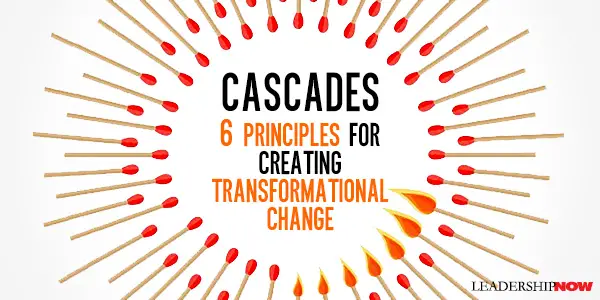
THE NATURE OF POWER has shifted from top-down to the center of networks. Networks are key to understanding how to create transformational change. As Niall Ferguson observed in The Square and the Tower, “Often the biggest changes in history are the achievements of thinly documented, informally organized groups of people.” In Cascades: How to Create a Movement that Drives Transformational Change, Greg Satell reveals how to start and sustain large-scale change and harness the power of cascades—small groups that are loosely connected but united by a common purpose. It is an insightful book with engaging examples of what has worked and what hasn’t. Forced change is not sustainable. “The role of leaders,” Satell writes, “is no longer to coerce action, but to inspire and empower belief.” He begins by explaining how small groups work and why. “Information spreads not through best friends but casual acquaintances.” It’s not connecting with the “influentials” because “change is a matter of networks and not nodes.” Satell explains the Threshold Model of collective behavior. As we all have different thresholds of conformity based on our on personal characteristics, there are varying thresholds of resistance in any group. For a trigger to spread it would depend on the distribution of resistance thresholds in a group. A person with a 0% threshold would throw the first rock, but if the rest of the group were of a higher resistance threshold, say 40%+, that would be the end of it. For a cascade to form, you need connections to higher threshold groups. “That’s a challenge because it means that you cannot only seek out the like-minded, you must also bring in the unconvinced, the skeptical, and the oblivious. If the desire to change remains with the zealots, it won’t go anywhere.” Satell distills from the lessons of history six principles for creating transformative change. He explains how each step “represents a crossroads where you will be tempted to make a point, but if you really want to make change happen, you will have to refocus your efforts on making a difference through building common ground.” 1. Identify a Keystone Change It starts with a grievance. “Yet to succeed, you must go beyond grievance to identify an affirmative vision for what you would like to be different and then identify a single, fundamental change that will bring that vision about.” For Gandhi it was salt. For Paul O’Neill of Alcoa, it was safety. The alternative you present must be better not just for the believers but for those outside the early adopter group. Speak to the common values to those outside your group. “The only way to win is to build a bond of trust that supersedes the economics of utility.” The keystone is critical. It’s not a matter of giving everyone something to create a majority of support. The keystone is a “fundamental issue that encapsulates the value of the mission—a keystone change that is concrete and tangible, unite the efforts of multiple stakeholders, and paves the way for greater change.” For Gandhi, the Salt Law was a grievance shared by everyone, and everyone could easily participate. It was only a matter of time for the dominos to fall. You must create a clear sense of purpose. “A lack of a clear purpose can hobble one almost before it starts.” The problem with the Occupy movement it that they fell in love with their own slogans and were never able to move past them. 2. Make a Plan Start with where you want to end up and figure out how to get there. Understand where the resistance comes from and ask how they can be convinced that this change is in their best interest or at least not worth fighting against. Who do you need to win over? While victory does not require you to win over all of those who resist change, you do need to erode the support of your opposition. …That’s why plans that are focused solely on rallying the faithful are doomed to fail. The only thing you accomplish is to harden the support of those who oppose your vision of change. Nobody wants to lose, but everybody wants a better tomorrow. 3. Build a Network of Small Groups Change does not happen alone. Often a single leader looms large like Gandhi, Nelson Mandela, or Martin Luther King, but they are just part of a deep network of groups that have been built up over time. They were masters of creating networks. To build a movement, you need a network of small groups linked together by a common purpose. Occupy Wall Street and Black Lives Matter didn’t gain traction because “in their quest to upend the establishment, they shunned any ties to existing institutions. Instead of puling in Pillars of Support, they actively pushed them away.” They didn’t allow others to connect to them. This is a key insight: To gain power, nascent movements must work to position themselves in the center of the networks around them. This has nothing to do with ideology. Many movements, including the struggles for independence in India and South Africa, and more recently, the LGBT movement, took what would once have been considered extreme positions. Yet by continually making new connections, they were able to shift the center of the networks and gain influence. In a nutshell: To grow, you have to connect, and the more you connect, the more central you become. The more central you become, the more power you have. And with enough power, you can bring change about. 4. Indoctrinate Genomes of Values You must stand for something. And these values must be communicated by and lived out through the behavior of the leadership. All adherents to the movement must internalize these values so that they become second nature to them. In the heat of the moment, it’s easy to toss them aside and respond inconsistently. “It feels good to reply to a snarky social media post with one that tops it. Yet the second you respond in the moment, you risk all of the work that has come before.” The following comment as told to Satell by Irving Wladawsky-Berger who retired from IBM in May of 2007, illustrates the need to understand what your value actually is. He recalls: At IBM we had lost sight of our values. For example, there was a long tradition of IBM executives dressing formally in a suit and tie. Yet that wasn’t a value, it was an early manifestation of a value. In the early days, many of IBM’s customers were banks, so IBM’s salespeople dressed to reflect their customers. So, the value was to be close to customers. Lou [Gerstner] reminded us of that, and we realized that if our customers now wore khakis, it was okay for IBMers to also wear khakis. How many manifestations of values do we treat as values in our organizations? 5. Create Platforms for Participation, Mobilization, and Connection A successful movement makes it easy for people to participate. The bar to entry is low. A nonviolent uprising invites more participation. “Unsuccessful movements rally the faithful and demonize those who don’t share their ideas or their commitment. They make their point but fail to make a difference.” Black Lives Matter and Bernie Sanders political campaign made this mistake. “Instead of reaching out, they seemed to revel in sticking their fingers in the eyes of potential allies, because to them only the most pure of heart belonged. Any deviation from strict doctrine was apostacy. That may rile up the most faithful supporters, but it alienates the rest of the Spectrum of Allies, and by limiting participation, greatly reduces the likelihood of success.” 6. Survive Victory It is common for change movements to fall apart after the objective has been met. Leaving the battle behind and learning to govern becomes key. “successful movements survive victory by staying true to their values even after the initial triumph.” As Gandhi remarked, we have to be the change. “It’s always easier to act in the moment or to prioritize an immediate need or desire than it is to sustain discipline and live up to the values you profess to believe in.” (Scott Cochrane provides a great example of that on his blog.) Maintenance comes after the victory. We must think about what comes next. “We are so focused on beating our opponents into submission that we fail to realize that they will eventually rise up again, learn the lessons of their failure, and return to fight with renewed vigor. That’s why we so often succeed in making our point, but fail to make a difference.” 
Posted by Michael McKinney at 12:07 AM
05.01.19

First Look: Leadership Books for May 2019Here's a look at some of the best leadership books to be released in May 2019. Don't miss out on other great new and future releases. Turn Enemies Into Allies: The Art of Peace in the Workplace (Conflict Resolution for Leaders, Managers, and Anyone Stuck in the Middle) by Judy Ringer Turn Enemies Into Allies: The Art of Peace in the Workplace (Conflict Resolution for Leaders, Managers, and Anyone Stuck in the Middle) by Judy Ringer
Leaders often believe they don’t have the time to help employees navigate conflict. It takes more time not to address conflict than to constructively intervene. But before you can successfully guide others in managing disagreements, you must be able to manage yourself—your mindset, presence, and behaviors. Turn Enemies into Allies offers a way of working with clashing employees that is deliberate and systematic. 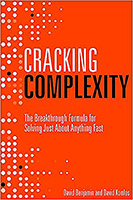 Cracking Complexity: The Breakthrough Formula for Solving Just About Anything Fast by David Komlos and David Benjamin Cracking Complexity: The Breakthrough Formula for Solving Just About Anything Fast by David Komlos and David Benjamin
Too many leaders approach complexity the wrong way—they push their people harder and harder and tackle problems one at a time over months, sometimes even years, and nearly always in a linear fashion. In this book, the authors share their proven formula for dramatically shortening the process and solving an organization's toughest challenges in mere days. 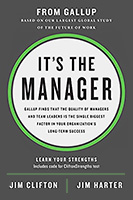 It's the Manager: Gallup finds the quality of managers and team leaders is the single biggest factor in your organization's long-term success by Jim Clifton and Jim Harter It's the Manager: Gallup finds the quality of managers and team leaders is the single biggest factor in your organization's long-term success by Jim Clifton and Jim Harter
Packed with 52 discoveries from Gallup’s largest study on the future of work, It’s the Manager shows leaders how to adapt their organizations to rapid change, ranging from new workplace demands to the challenges of managing remote employees, a diverse workforce, the rise of artificial intelligence, gig workers, and attracting—and keeping—today’s best employees. 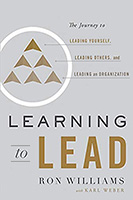 Learning to Lead: The Journey to Leading Yourself, Leading Others, and Leading an Organization by Ron Williams with Karl Weber Learning to Lead: The Journey to Leading Yourself, Leading Others, and Leading an Organization by Ron Williams with Karl Weber
This master class on leadership, written by one of America's most prominent and successful executives, will help you develop the professional leadership qualities that deliver personal, interpersonal, and organizational success. Ron Williams provides you with practical, tested leadership advice, whether you're searching for a new career, looking for proven management solutions, or seeking to transform your organization. 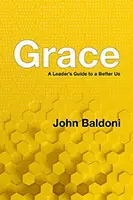 Grace: A Leader's Guide to a Better Us by John Baldoni Grace: A Leader's Guide to a Better Us by John Baldoni
GRACE: A Leader's Guide to a Better Us focuses on the role that grace plays as a catalyst in enabling us to create "the greater good" at work, at home and in our communities. GRACE tells the stories of women and men who are making a positive difference in our world by devoting themselves to serving as agents of positive change. GRACE is a clarion call for the goodness in the world around us as well as a practical guide for implementing grace in your own life. 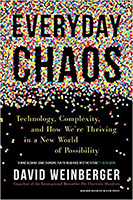 Everyday Chaos: Technology, Complexity, and How We’re Thriving in a New World of Possibility by David Weinberger Everyday Chaos: Technology, Complexity, and How We’re Thriving in a New World of Possibility by David Weinberger
Through stories from history, business, and technology, philosopher and technologist David Weinberger finds the unifying truths lying below the surface of the tools we take for granted--and a future in which our best strategy often requires holding back from anticipating and instead creating as many possibilities as we can.  Build your leadership library with these specials on over 39 titles. All titles are at least 40% off the list price and are available only in limited quantities. “No two persons ever read the same book.” — Edmund Wilson
 
Posted by Michael McKinney at 10:21 AM
|
BUILD YOUR KNOWLEDGE


How to Do Your Start-Up Right STRAIGHT TALK FOR START-UPS 
Grow Your Leadership Skills NEW AND UPCOMING LEADERSHIP BOOKS 
Leadership Minute BITE-SIZE CONCEPTS YOU CAN CHEW ON 
Classic Leadership Books BOOKS TO READ BEFORE YOU LEAD |
|